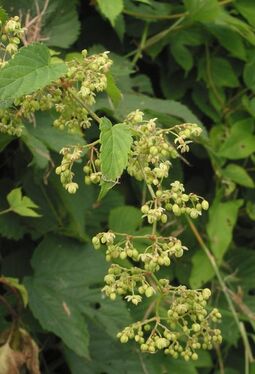Cannabaceae
| Cannabaceae | ||||||||||
|---|---|---|---|---|---|---|---|---|---|---|
 Cannabis sativa | ||||||||||
| Plant Info | ||||||||||
|
| ||||||||||
| Scientific classification | ||||||||||
| ||||||||||
| Genera | ||||||||||
| Cannabis - Hemp Celtis - Hackberry |
Cannabaceae is a small family of flowering plants.
According to the Royal Botanical Gardens database, there are 170 species grouped in nine to fifteen genera, including three well-known genera Cannabis (hemp), Humulus (hops) and Celtis (hackberries). Celtis is by far the largest genus, counting 100 species.
Taxonomy
Cannabaceae used to be part of the order Urticales, which is now included into Rosales. The family is closely allied with the other families of the old Urticales, Moraceae, Urticaceae, and Ulmaceae. The old Urticales are sister to the rest of Rosales.
Celtis is peculiar among Cannabaceae, as it is a tall tree and it is not dioecious. It was previously included either in the strictly related family Ulmaceae (the elm family) or their own family the Celtidaceae, and has been recently included into Cannabaceae by the Angiosperm Phylogeny Group after genetic analysis.
Description
Cannabaceae are very similar to Moraceae. Members of this family can be trees (e.g. Celtis), erect or twining herbs (e.g. Cannabis and Humulus respectively).
Leaves are often more or less palmately lobed or palmately compund and always bear stipules. Cystoliths are always present and some members of this family are laticifers.
Cannabaceae are often dioecious (distinct male and female plants). The flowers are actinomorphic (radially symmetrical) and not showy, as these plants are pollinated by the wind. As an adaptation to this kind of pollination, the calyx is short and there is no corolla. Flowers are grouped to form cymes. In the dioecious plants the masculine inflorescences are long and look like panicles, while the feminine are shorter and bear less flowers.The pistil is made of two connate carpels, the usually superior ovary is unilocular; there is no fixed number of stamens.
The fruit can be an achene or a small nut.
Uses
Hop (Humulus lupulus) is cultivated for its fruits which contain aromatic substances used in the production of beer. Its young shoots are used as vegetable. Different subspecies of hemp (Cannabi sativa) are cultivated for the production of fiber, as a source of cheap oil or to produce recreational and medicinal marijuana.




